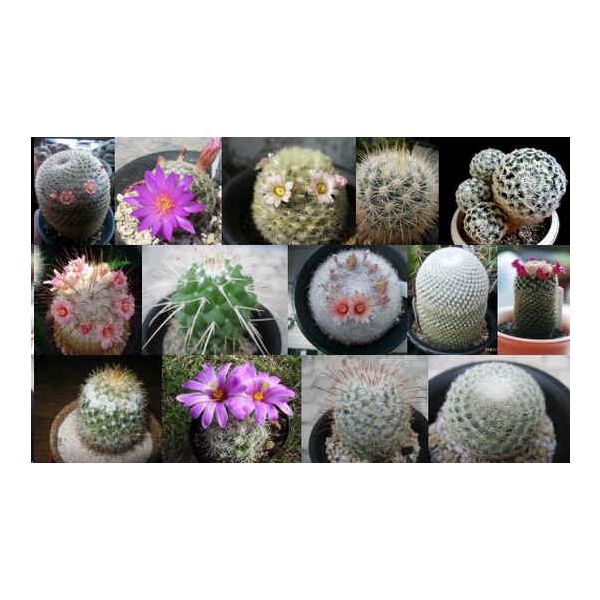Mammillaria Seeds Mix
Mammillaria Seeds Mix
This genus is the most popular one among cacti. There are societies throughout the world that strictly consist of Mammillaria aficionados, and there are collectors who specialize in this genus exclusively.

Delivery
All orders shipped with UPS Express.
Always free shipping for orders over US $250.
All orders are shipped with a UPS tracking number.
Returns
Items returned within 14 days of their original shipment date in same as new condition will be eligible for a full refund or store credit.
Refunds will be charged back to the original form of payment used for purchase.
Customer is responsible for shipping charges when making returns and shipping/handling fees of original purchase is non-refundable.
All sale items are final purchases.
Help
Give us a shout if you have any other questions and/or concerns.
Email: contact@domain.com
Phone: +1 (23) 456 789
Availability: In stock
SKU
Mammillaria
The genus Mammillaria is the largest in the cactus family (Cactaceae), with currently 171 known species and varieties recognized. Most of the Mammillaria are native to Mexico, but some come from the southwest USA, the Caribbean, Colombia, Venezuela, Guatemala and Hondura.
This genus is the most popular one among cacti. There are societies throughout the world that strictly consist of Mammillaria aficionados, and there are collectors who specialize in this genus exclusively. New species are still being encountered in nature to this day; it is estimated that during the past 30 years some 50 new species have been discovered. The first was described by Carolus Linnaeus as Cactusmammillaris in 1753, deriving name from Latin mammilla, "nipple", referring to the tubercles that are one of the plant's specific features.
The distinctive feature of the genus is the specific development of an areole that is split into two clearly separated parts, one occurring at the tubercle's apex, the other at its base. The apex part is spine bearing, and the base part is always spineless, but usually bearing some bristles or wool. The base part of the areole bears the flowers and fruits, and is a branching point. The apex part of the areole does not carry flowers, but in certain conditions can function as a branching point as we.
The plants are usually small, globose to elongated, the stems from 1 - 20 cm in diameter and from 1 - 40 cm tall, clearly tuberculate, solitary to clumping forming mounds of up to 100 heads and possess radial symmetry. Tubercles can be conical, cylindrical, pyramidal or round. The roots are fibrous, fleshy or tuberous. The flowers are funnel-shaped and range from 7 - 40 mm and more in length and in diameter, from white and greenish to yellow, pink and red in color, often with a darker mid-stripe; the reddish hues are due to betalain pigments as usual for Caryophyllales. The fruit is berry-like, club-shaped or elongated, usually red but sometimes white, yellow or green. Some species have the fruit embedded into the plant body. The seeds are black or brown, from 1 - 3 mm in size.
| Common name | Mammillaria Mix |
|---|---|
| Species | Mammillaria ssp. |
| Germination | In general, Mammillaria are easy to grow, except for the small or miniature species which need constant attention or require grafting. First of all, the pots used need to be disinfected. Then, prepare the soil; first sift the earth and coco peat to take out all the pieces that are too big or too hard. The only difference with usual soil is the addition of one part of chippings (tiny gravel). For sowing, use pots of 5x5x4.5 cm (LxlxH) that are filled up to 0.5 cm from the upper side; the soil is slightly tamped with a piece of wood, the labels are placed and the seeds are put in, and again slightly tamped. As soon as the pots are ready, place them in a tray containing boiled and cooled off rain water. Then, place the pots in a mini-greenhouse that is heated at about 28C during the day and that cools off at night to 18C. For the germination period, attention should be paid that the soils remains moistened. The seeds will need lighting from 7 AM to 10 PM, (15 hours). Make sure that all the pots receive enough light. The seedlings should remain in there for about three months, afterwards, they won?t need the heat in the mini-greenhouse and you should start ventilating them and getting them acquainted with the adult living conditions. A first potting on is done after about 6 months, but that can be done much later as well, even after a year. Germination can take longer. Be patient! Several taxa are threatened with extinction, at least in the wild, due to habitat destruction and especially over collecting for the pot plant trade. Cactus fanciers can assist conservation of these rare plants by choosing nursery-bred specimens. Besides helping to preserve rare plants, one can gain experience in growing and breeding cacti in general with nursery-bred rare mammillaris: several mammillaris are quite easy (for cacti) to grow from seeds. One such species, popular and widely available from nursery stock but endangered in the wild, is Mammillaria zeilmannian. |
| Price View | Price Range |

